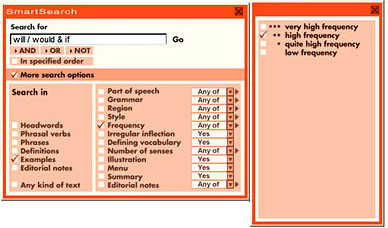|

FROM THE EDITOR
 Welcome Welcome
 Contributors Contributors
 Write
to Us Write
to Us
FEATURE
 MED
CD-ROM: MED
CD-ROM:
the ideal self-study tool
Learner training and vocabulary, pronunciation, language skills work
outside the classroom
COLUMNS
 Language Interference Language Interference
Learner English and its uses
Why do Inspector Clouseau
and Ali G sound funny?
 Focus
on Language Awareness: Pragmatics Focus
on Language Awareness: Pragmatics
The key to avoiding slips
UK version ¦ US
version
 New
word of the month New
word of the month
'
I know how to spell banana,
but I don’t know when to stop!'
 Top
Tips for the CD-ROM Top
Tips for the CD-ROM
Create your own activities with SmartSearch
 onestopenglish.com onestopenglish.com
|
|
Creating activities with
SmartSearch: Conditionals
by
Mairi
MacDonald
Want additional examples of a grammar
point or vocabulary theme but don’t have time to think up example
sentences? The Macmillan English Dictionary possesses a
sophisticated search tool that helps you create supplementary materials
quickly.
Using SmartSearch
- Select the SmartSearch from the
title bar.
- Check More search options.
- Check Examples.
- Type in will / would & if and
click Go.

This produces over 170 examples
of the First, Second and Third Conditionals. To narrow down the results,
select Frequency and
** high frequency and click Go.
To copy the examples:
- Select the example sentence you want and right click.
- Select Copy selected text from
the menu.
- Paste the text into your usual word
processing program.
Tip
Save the complete list of example
sentences as a separate file
so you can
reuse them in the future.
Once you have a list of example
sentences, you can use your word processor to create all sorts of
activities – here are a few possibilities:
| A
Matching sentences
Aim:
To identify structural differences between the First, Second and
Third Conditionals.
Activity:
Students have to match two parts of a sentence to make a
grammatically correct statement.
See
the activity
and the answers
Create the activity:
- Select 5 examples from each
conditional.
- Create a table 2 cells across
and 15 cells down.
- Cut and paste a clause into
each cell.
- Cut the table and mix the
sentence halves.
|
top
| B
Gap fill: First and Second Conditionals
Aim:
To revise the First and Second Conditionals.
Activity:
Students have to complete the sentences using will or would.
See
the activity
and the answers
Create the activity:
- Select 10 sentences from the
First Conditional and 10 from the Second Conditional.
- Using Find and Replace, type
in will in the Find box and ________ in
the Replace box.
- Do the same with would.
- Now use Table>Sort to
rearrange the sentences into alphabetical order. This will
rearrange the sentences.
Finally, highlight all the
sentences and click on the number button to complete the
worksheet. |
top
| C Open
sentences
Aim:
To practise the First, Second and Third Conditionals.
Activity:Pair work
Students complete the
unfinished sentences and then swap with another pair to try and
identify mistakes.
See
the activity and the
example answers
Create the activity:
- Select the examples
appropriate for the level you are teaching.
- Delete the second clause so
that only the if clause remains.
|
top |





